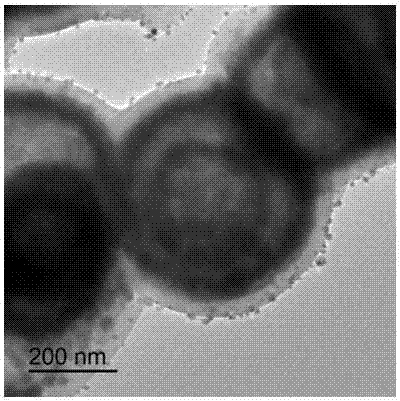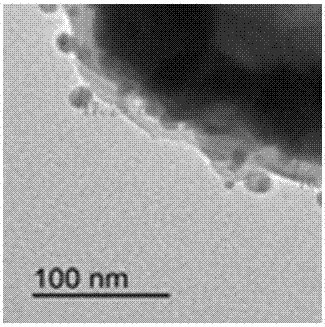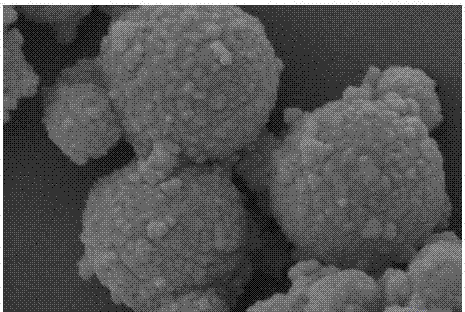Preparation method of composite core-shell nano hollow ball and application of composite core-shell nano hollow ball in dye-sensitized solar cell
A technology of hollow spheres and composite cores, applied in the field of solar cells, can solve problems such as difficulty and limited semiconductor materials, and achieve the effects of easy operation, improved light utilization, and reduced surface defects
- Summary
- Abstract
- Description
- Claims
- Application Information
AI Technical Summary
Problems solved by technology
Method used
Image
Examples
example 1
[0034] 1. Double-layer CeO 2 : Preparation of Yb / Er:
[0035] (1) Under ultrasonic conditions, completely disperse 1 g of urea in 170 mL of ultrapure water to obtain a urea dispersion, then add 80 mL of trisodium citrate aqueous solution with a concentration of 10 mM / L to the urea dispersion, and stir vigorously for 15 minutes to obtain Urea dispersant of trisodium citrate.
[0036] (2) Dissolve 1.2g of cerous chloride heptahydrate in 32mL of water to form a solution with a concentration of 0.1M. Take 23.8mL and add it to the above-mentioned urea dispersant of trisodium citrate. After stirring for 15min, add 74uL with a concentration of 0.1M M of ytterbium nitrate solution and 740uL of 0.1M erbium nitrate solution. Under vigorous stirring, 1 mL of hydrogen peroxide solution with a concentration of 30% (mass percentage) was added dropwise, and a light yellow mixed solution was obtained after 45 min.
[0037] (3) The obtained pale yellow mixed solution was transferred to a hi...
example 2
[0046] 1. Double-layer CeO 2 : Preparation of Yb / Er:
[0047] (1) Under ultrasonic conditions, completely disperse 2 g of urea in 340 mL of ultrapure water to obtain a urea dispersion, then add 160 mL of trisodium citrate aqueous solution with a concentration of 10 mM to the urea dispersion, stir vigorously for 15 minutes, and obtain citric acid Trisodium urea dispersant.
[0048] (2) Dissolve 2.4g of cerous chloride heptahydrate in 64mL of water to form a solution with a concentration of 0.1M. Take 47.6mL and add it to the above-mentioned urea dispersant of trisodium citrate. After stirring for 15min, add 148uL with a concentration of 0.1M M of ytterbium nitrate solution and 1.48 mL of 0.1M erbium nitrate solution. Under vigorous stirring, 2 mL of hydrogen peroxide solution with a concentration of 30% (mass percentage) was added dropwise, and a light yellow mixed solution was obtained after 45 min.
[0049] (3) Transfer the obtained pale yellow mixed solution to a high pre...
example 3
[0058] 1. Double-layer CeO 2 : Preparation of Yb / Er:
[0059] (1) Under ultrasonic conditions, completely disperse 10 g of urea in 1.7 L of ultrapure water to obtain a urea dispersion, then add 800 mL of trisodium citrate aqueous solution with a concentration of 10 mM / L to the urea dispersion, and stir vigorously for 15 minutes , to obtain a urea dispersant of trisodium citrate.
[0060] (2) Dissolve 12g of cerous chloride heptahydrate in 320mL of water and prepare a solution with a concentration of 0.1M. Take 238mL and add it to the above-mentioned urea dispersant of trisodium citrate. After stirring for 15 minutes, add 740ul of 0.1M Ytterbium nitrate solution and 7.4 ml of 0.1 M erbium nitrate solution. Under vigorous stirring, 10 mL of hydrogen peroxide solution with a concentration of 30% (mass percentage) was added dropwise, and a light yellow mixed solution was obtained after 45 min.
[0061] (3) Transfer the obtained pale yellow mixed solution to a high pressure reac...
PUM
| Property | Measurement | Unit |
|---|---|---|
| diameter | aaaaa | aaaaa |
| particle diameter | aaaaa | aaaaa |
| particle diameter | aaaaa | aaaaa |
Abstract
Description
Claims
Application Information
 Login to View More
Login to View More - R&D
- Intellectual Property
- Life Sciences
- Materials
- Tech Scout
- Unparalleled Data Quality
- Higher Quality Content
- 60% Fewer Hallucinations
Browse by: Latest US Patents, China's latest patents, Technical Efficacy Thesaurus, Application Domain, Technology Topic, Popular Technical Reports.
© 2025 PatSnap. All rights reserved.Legal|Privacy policy|Modern Slavery Act Transparency Statement|Sitemap|About US| Contact US: help@patsnap.com



